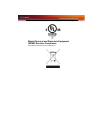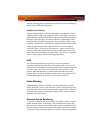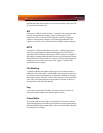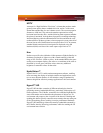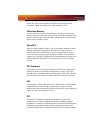
115
Brightness
The amount of white or black that is applied to all colors onscreen. By
making the screen “brighter” you are adding more white to it. This should
not be confused with luminosity, which measures the actual light level
emitted from the computer display.
Buffer
A name referring to portions of on-board video memory. One large buffer
is always used to display images to the screen; this is the “display buffer.”
The rest of offscreen memory is typically used by applications as back
buffers, z-buffers, and texture buffers.
Catalyst™ Control Center
Catalyst™ Control Center is the successor technology to the Catalyst™
software formerly available only through the Windows® Control Panel. It
has a new user interface, providing a more interactive means of controlling
such things as 2D and 3D performance while providing immediate
feedback using a more intuitive graphical user interface.
Color Component
Three color components—Red, Green, and Blue—combine in various
intensities to determine the color of each pixel on the screen. The values of
each color component are graphically represented by a corresponding color
curve.
Color Correction
Correct discrepancies between the real color value and the way a screen
displays it. Color discrepancies can be caused by a variety of sources,
including the lighting conditions in the work area and gradual shifts in color
over time on monitors or flat panel displays.
Color Depth
Color depth refers to the number of color shades available on your display
and is measured in bits per pixel (bpp). Typical ranges are: 256 colors
(8bpp), thousands of colors (16bpp), and millions of colors (32bpp).





